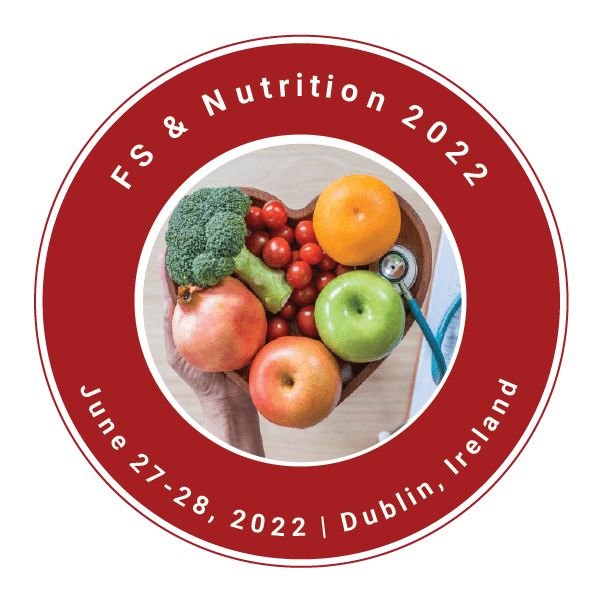Conference Information
Welcome Message
Join us for Annual Congress on Food Science and Nutrition
I feel very honoured that I got an opportunity to invite you all in the “Annual Congress on Food Science and Nutrition” is planned to take place on June 06-07, 2022, in Dublin, Ireland. Food Science and Nutrition intends to host all the well-known Nutritionists, Researchers, Food Researchers, Health care faculty, Medical professionals, Fellowship holders, Residents, Food industries and Healthcare professionals related to the field of Food Science.
The conference with the theme: “Craving Latest Trends and Advancements in Food Science and Nutrition”
FS & Nutrition will be a venue for exploring the advances in the field of Nutrition Congress. In this gathering, the major advances in techniques, materials and procedural changes related to Food technology will be discussed and outcomes of the procedures are to be shared. This conference will serve a unique opportunity for the delegates of Medical Universities, Industries, and companies as it allows people to interact with industry leading Nutritionists, Researchers, and Businesspersons.
FS & Nutrition 2022 will not only be a venue hosting the largest gathering of Nutritional Doctors and related professionals, but also attempts to spread Knowledge on advances in the ever-changing field of Food Technology. Food Science and Nutrition includes Keynote speeches, plenary speakers, and Oral and Poster presentations. The interested professionals can confirm their participation by registering in FS & Nutrition 2022. Each of you has a different background and a different primary scientific specialty. This mix of expertise is the secret for our conference success. Prepare yourself for the best scientific discussion, listen with an open mind, and discuss and share ideas.
Best Regards,
Organising Committee,
Miya Williams
Introduction
About Pulsus
Pulsus Group is an internationally renowned medical peer-review publisher and conferences organizer established in the year 1984 publishes and hosts the work of researchers in a manner that exemplifies the highest standards in research integrity.
Pulsus Conferences explore the future by connecting minds and spreading brilliance at Pulsus Group annual conferences & meetings. Meet your colleagues, discuss your specialty, spread and aid, learn & grow in association with 1000+ scientific societies from The USA, Europe, The Middle East, Africa and The Asia-Pacific region. Pulsus group is closely associated with globally renowned academic and research societies.
Pulsus Conferences believe that true technology and innovation depends on hearing from, and listening to, people with a variety of perspectives. Pulsus Conferences enhances the technology for people from underrepresented groups by actively recruiting diverse speakers for our events, signing up a broad variety of authors for journals and videos, and taking part in ongoing conversations about the value of diversity in the communities we serve.
Pulsus Group Journals
EB Members
Why to attend?
FS & Nutrition 2022 anticipates hundreds of delegates including international keynote lectures and oral presentations by renowned speakers and poster presentations by students, Exhibitions and delegates all around the world which will craft a platform for global promotion and effective development in this field. It provides international networking and opportunities for collaborations with worldwide companies and industries.
This global event will be an excellent opportunity for the Nutrition and Food Scientists and other professionals. We are anticipating around 100+ speakers and over 200 delegates for this esteemed congress.
Who should attend?
Target Audience:
- Healthcare Students, Scientists and professors
- Food Researchers
- Healthcare Faculty
- Medical Colleges
- Healthcare Associations and Societies
- Business Entrepreneurs
- Training Institutes
- Conference Opportunities
For Researchers and Faculty Members:
- Speaker Presentations
- Poster Display
- Symposium hosting (4–5-member team)
- Workshop organizing
For Universities, Associations & Societies:
- Association Partnering
- Collaboration proposals
- Academic Partnering
- Group Participation
For Students and Research Scholars:
- Poster Competition (Winner will get Best Poster Award)
- Young Researcher Forum (YRF Award to the best presenter)
- Student Attendee
- Group registrations
For Business Delegates:
- Speaker Presentations
- Symposium hosting
- Book Launch event
- Networking opportunities
- Audience participation
For Product Manufacturers:
- Exhibitor and Vendor booths
- Sponsorship’s opportunities
- Product launch
- Workshop organizing
- Scientific Partnering
- Marketing and Networking with clients
Sessions And Tracks
Session On Family Medicine & Women's Health:


Family medicine is a medical specialty within primary care that provides continuing and comprehensive health care for the individual and family across all ages, genders, diseases, and parts of the body. The specialist, who is usually a primary care physician, is named a family physician. Family medicine and family physicians play a very important role in the healthcare system of a country. In the U.S., for example, nearly one in four of all office visits are made to family physicians.
- Maintaining Balanced Diet
- Physical Exercises
- Mental health
- Chronic diseases
- Heart Diseases
- Breathing Issues(Asthma)
- COPD
- Diabetes, hypertension
- Arthritis
Women's health differs from that of men in many unique ways. Women's health is an example of population health, where health is defined by the World Health Organization as "a state of complete physical, mental and social well-being and not merely the absence of disease or infirmity". Often treated as simply women's reproductive health, many groups argue for a broader definition pertaining to the overall health of women, better expressed as "The health of women". These differences are further exacerbated in developing countries where women, whose health includes both their risks and experiences, are further disadvantaged. Women's reproductive and sexual health has a distinct difference compared to men's health. Even in developed countries pregnancy and childbirth are associated with substantial risks to women with maternal mortality accounting for more than a quarter of a million deaths per year, with large gaps between the developing and developed countries.
- Birth Control, HIV and HPV
- Breast Implants
- Caregiving
- College Health
- Diabetes
- Healthy Aging
- Heart Health
- High Blood Pressure (Hypertension)
- Mammograms
- Menopause
- Pregnancy
- Safe Medication Use
- Women and Pain Medicines
- Other Topics like cosmetics and nutrition
- Obesity
Note: Good nutrition, daily exercise and adequate sleep are the foundations of healthy living. A healthy lifestyle keeps you fit, energetic and at reduced risk for disease.
Related Keywords: Food | Food Industry | Food & Beverage | Food & Drink | ADME Process
Related Associations: Association of Food Scientists | International Association of Food Protection | The food industry association | The Association of Food Industries
Session on Food:

Food, substance consisting essentially of protein, carbohydrate, fat, and other nutrients used in the body of an organism to sustain growth and vital processes and to furnish energy the absorption and utilization of food by the body is fundamental to nutrition and is facilitated by digestion. Plants, which convert solar energy to food by photosynthesis, are the primary food source. Animals that feed on plants often serve as sources of food for other animals. To learn more about the sequence of transfers of matter and energy in the form of food from organism to organism, see food chain
Food is treated in several articles. For a description of the processes of absorption and utilization of food, nutrition, human; digestion; and digestive system, human. For information on the methods used to prepare raw foods for cooking, consumption, or storage, sees food preservation.
- Microorganisms in the bio-processed foods
- Use of enzymes production in food industry
- Nutrients in Biochemistry
- Environmental Impact of Food Production and Composition
- Food Analysis
Related Keywords:Food | Food Industry | Food & Beverage | Food & Drink | ADME Process
Related Associations: Association of Food Scientists | International Association of Food Protection | The food industry association | The Association of Food Industries
Session on Food Science:

Food Science is a multi-disciplinary field involving chemistry, biochemistry, nutrition, microbiology, and engineering to give one the scientific knowledge to solve real problems associated with the many facts of the food system. The microbiology and the safety aspects of food must also be understood. Food innovation and Technology is the development and commoditization of new food products, processes and services. Food and beverages companies are looking for ways to make healthy, nutritious offerings that are not only enticing, accessible, exciting and unique but also sustainable.
- Food Engineering
- Food Toxicology
- Food Microbiology
- Food Packaging
- Food Preservation
- Food Biotechnology
- Nutritional food
Related Keywords: Food | Food Industry | Food & Beverage | Food & Drink | ADME Process
Related Associations: Association of Food Scientists | International Association of Food Protection | The food industry association | The Association of Food Industries
Session on Nutrition:
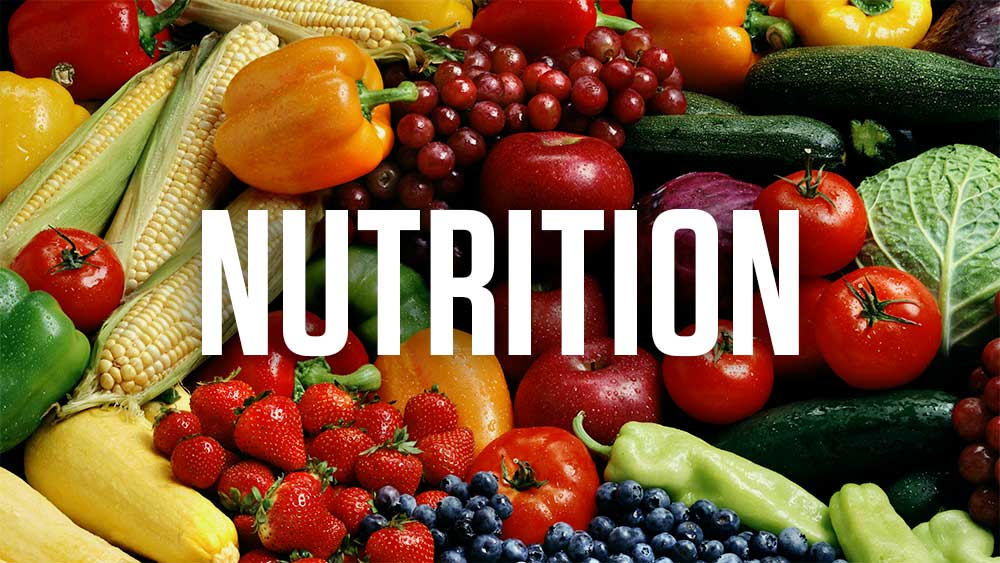
Nutrition is the science that interprets the interaction of nutrients and other substances in food in relation to maintenance, growth, reproduction, health and disease of an organism. It includes food intake, absorption, assimilation, biosynthesis, catabolism, and excretion. The role of nutrition in aging. Nutritional requirements do not change appreciably with age among adults. The reduction in food intake and the tendency of old people to eat the same diet day after day makes them potentially vulnerable to possible deficiencies in specific vitamins, minerals, and protein.
- Principles of Nutrition and Nutritional Biochemistry
- Guidelines for Good Health
- Therapeutic Diets and Effective Nutritional Counselling
- Function of Nutrition
- Nutrition and Health Policy
Related Keywords: Food | Food Industry | Food & Beverage | Food & Drink | ADME Process
Related Associations: Association of Food Scientists | International Association of Food Protection | The food industry association | The Association of Food Industries
Session on Nutritional Science:

Nutritional science deals with the organism’s responses to the diet. It includes studies not only on the nutrients themselves but also on molecular interactions, metabolic and signalling pathways, physiology, pathology, and toxicology. The science of nutrition developed out of discoveries in modern chemistry and medicine. Nutritional science has had a major impact on public health by identifying optimal nutrient intakes on a population-wide basis.
- Cellular and Molecular Nutrition
- Nutritional Immunology
- Nutritional Endocrinology
- Role of Nutrition in Neuroscience
- Nutrition and Cardiovascular Disease
- Nutritional Endocrinology
- Nutritional Epidemiology
- Eternal and Parenteral Nutrition
Related Keywords: Food | Food Industry | Food & Beverage | Food & Drink | ADME Process
Related Associations: Association of Food Scientists | International Association of Food Protection | The food industry association | The Association of Food Industries
Session on Food Chemistry:
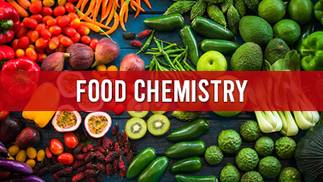
Food Chemistry focuses on the composition and structure changes in molecules induced by processing, distribution and domestic conditions of foods and food products during their different processing stages and storage periods. Food Chemistry has rapid development in the past few decades based on modern chemistry and biochemistry. Microorganisms involved in food microbiology include bacteria moulds and yeasts. Bacteria mainly cause food intoxication and food spoilage thereby causing various humans get health diseases, Probiotic bacteria, including which produces bacteriocins can kill and inhibit pathogens. Alternatively, purified bacteriocins such as nisin can be added directly to food products for food safety.
- Food Toxicology
- Organic Molecules
- Food Biotechnology
- Food Quality
- Chemical additives and toxins
Related Keywords: Food | Food Industry | Food & Beverage | Food & Drink | ADME Process
Related Associations: Association of Food Scientists | International Association of Food Protection | The food industry association | The Association of Food Industries
Session on Food omics & Food Security:

Food omics requires the combination of food chemistry, biological sciences and data analysis. It greatly helps the scientists in an area of food science and nutrition to gain a better access to data, which is used to analyse the effects of food on human health. It is believed to be another step towards better understanding of development and application of technology and food. Food security, as defined by the United Nations’ Committee on World Food Security, means that all people, at all times, have physical, social, and economic access to sufficient, safe, and nutritious food that meets their food preferences and dietary needs for an active and healthy life. Such as balancing the nutritional benefits of meat against the ecological costs of its production
- Evolution of food during digestion
- Nutrition and health
- Medicine and Biosciences
- For the Poor Sections of the society
- Chronic & Seasonal Hunger (Starvation)
Related Keywords: Food | Food Industry | Food & Beverage | Food & Drink | ADME Process
Related Associations: Association of Food Scientists | International Association of Food Protection | The food industry association | The Association of Food Industries
Session on Nutrigenetics & Nutrigenomics:
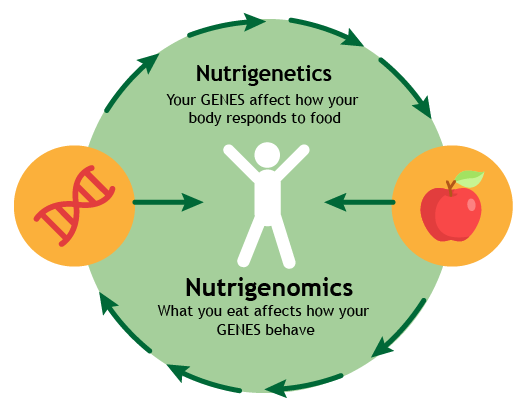
Nutrigenomics which is the integration of the study of nutrition, gene and omics and can help with personalized health and nutrition intake by assessing individuals and make specific nutritional requirements. The focus is on the prevention and the correction of specific genetic disorders. It influences the genetic variation on nutrition by correlating gene expression and with nutrient’s absorption, metabolism, elimination or biological effects. Nutrigenetics on the other hand identifies how the genetic makeup of a particular individual co-ordinates his or her response to various dietary nutrients. It also reveals why and how people respond differently to the same nutrient (or drugs).
- Nutrition gene interaction (DNA, RNA, SNPs)
- Food Constituents on Gene Expression
- Type II Diabetes, Obesity, Heart disease
- Links of Chronic Diseases
- Genome Damage and Nutritional Deficiency
Related Keywords: Food | Food Industry | Food & Beverage | Food & Drink | ADME Process
Related Associations: Association of Food Scientists | International Association of Food Protection | The food industry association | The Association of Food Industries
Session on Food Processing & Adulteration:

Food processing has come to be associated with ramen noodles, canned meat, and spongy snack cakes. The health concerns raised by these products have led many to assume that all processed foods are unhealthy, but do they deserve their reputation? Businesses use food processing techniques to transform raw foods and ingredients into new products. These techniques run the gamut and include milling grains into flour, crushing seeds to extract their oil, churning milk into butter, mixing ingredients to make batter, and baking cookies on an assembly line. Meat processing, meanwhile, can involve techniques like cutting, deboning, and removing guts from carcasses. Thousands of years before food scientists figured out how to make dinosaur-shaped chicken nuggets, early Egyptians were brewing beer and baking leavened bread. Today, for better and for worse, nearly all our food is processed in some way. Food processing offers important benefits to businesses and consumers, including a more varied food supply and foods with a longer shelf life. Certain aspects of food processing, however, raise concerns over dietary health, worker health, and food safety.
Food adulteration, whether motivated by economic fraud or malicious food tampering, can have serious effects on health and safety. Today, people are more aware than ever of the risks of food adulteration, and updated regulations reflect the need to have more protection at the government and industry level. For instance the Food Safety Modernization Act in the US mandates that food safety plans contain strategies to lessen the risk of food adulteration, with businesses held liable should adulterated products be released into commerce. When a substance is termed an ‘adulterant’, stronger penalties apply, including the possibility of criminal liability.
- Mixing
- Substitution
- Concealing quality
- Decomposed food
- Misbranding/ False labels
- Addition of toxicants
- Cancer and Stomach disorders
Related Keywords: Food | Food Industry | Food & Beverage | Food & Drink | ADME Process
Related Associations: Association of Food Scientists | International Association of Food Protection | The food industry association | The Association of Food Industries
Session on Food-Borne Illness:

Foodborne ailment also well-known as food poisoning is an infection which is caused due to eating of food with adulterated microorganism or pathogenic bacteria. It might be ensued due to inappropriate maintenance and adulterated utensils, improper temperature of potentially hazardous food, food from unsafe sources. Food allergies have no treatment, but with early identification and taking the proper safeties when selecting foods, the effects of the food allergies can be minimized.
Food allergy is a state arises under food borne illness which conveys allergen from food and reacts with immune system. Allergy triggering food which react with the body, elicit signs and symptoms such as digestive problems, hives, etc.
- Double Vision
- Difficulty in Breathing
- Dizziness
- Kidney Failure
- Abdominal Cramps
- Virus, Parasites, Bacteria, Yeast, Fungi
Related Keywords: Food | Food Industry | Food & Beverage | Food & Drink | ADME Process
Related Associations: Association of Food Scientists | International Association of Food Protection | The food industry association | The Association of Food Industries
Session on Nutrification and Healthy Aging:

Nutrification is nothing but enriching the foods by addition of nutrients to foods at such a level as to make a major contribution to the diet. Fortification plays a major role in Nutrification. Fortification is a process of adding micronutrients to food where staple foods can lack in particular nutrients due to soil of the region. Food fortification is was initiated to replace the nutrients which were lost during the product manufacturing, for public health intervention, to ensure the nutritional equivalence of substitute food and the appropriate vitamin and mineral nutrient.
The role of nutrition in aging Nutritional requirements does not change appreciably with age among adults. The reduction in food intake and the tendency of old people to eat the same diet day after day makes them potentially vulnerable to possible deficiencies in specific vitamins, minerals, and protein.
- Types and Methods of Food Fortification
- Technical Aspects of Food Fortification
- Effectiveness and Food Fortification Tools
- Mental Stimulation, Social Activities
- Biochemical Reactions
Related Keywords: Food | Food Industry | Food & Beverage | Food & Drink | ADME Process
Related Associations: Association of Food Scientists | International Association of Food Protection | The food industry association | The Association of Food Industries
Session on Mental health & Mental disorder:

Mental disorders are health conditions they are characterized by changes in state of mind, mood and behaviour that are related with pain or hypothetically disabled working. Mediterranean Diet is considered a beneficial diet for overall health and brain health. Poor nutrition can lead to physical health problems in obesity. People who don’t have a healthy diet to report symptoms of depression or other mental health issues and there appears to be some association between nutrients in food and emotional welfare.
- Adult/Children Counselling
- Advanced treatments in mental illness
- Multiple Personality disorders
Related Keywords: Food | Food Industry | Food & Beverage | Food & Drink | ADME Process
Related Associations: Association of Food Scientists | International Association of Food Protection | The food industry association | The Association of Food Industries
Session on Pediatric nutrition:

Pediatric nutrition studies the dietary requirements of children to support growth and changes in organ function and body composition. Vigorous consumption in childhood and adolescence is chief for proper growth and development and plays vital role in preventing several health conditions. Nutrient-enriched diet aid the children to attain and maintain a healthy body weight and reduce the risk of developing health conditions such as High blood pressure, Heart disease, Type 2 diabetes, Cancer, and Iron deficiency.
Growth is vital characteristic of infantile, and a profound indicator of the child’s nutritional eminence. Paediatrics Nutrition aids in the conservation of a proper well-balanced diet and endure the physiologic necessities at the different phases of a child's growth. Breast Feeding has vital ingredients that are not found in any infant formulation, to construct the baby’s immune system.
- Carbohydrate Malabsorption
- Disorders of Vitamin Absorption
- Iron Deficiency Anaemia
- Malabsorption
- Nourishing Growing Child
- Pediatrics Rheumatology
- Pediatrics Nutrition in Chronic Diseases
Related Keywords: Food | Food Industry | Food & Beverage | Food & Drink | ADME Process
Related Associations: Association of Food Scientists | International Association of Food Protection | The food industry association | The Association of Food Industries
Session on Sports & Clinical Nutrition:

Sports nutrition should include everything you consume in a day not just what you eat or supplement with around exercise or during a competition. Understanding what and when to eat on a daily basis will have a huge impact on your performance, mood, sleep, health and energy levels which should not be underestimated.
A very stimulating subject of sport nutrition is the use of supplements like proteins and metabolism of lipids. Sports Nutrition stresses on study of the type and quantity of fluids and foods consumed by an athlete. Intake of nutrients like vitamins, minerals, supplements and organic ingredients that comprise carbohydrates, proteins and facts
Clinical nutrition centres on the prevention, diagnosis, and management of nutritional variations in patients connected to chronic diseases and conditions primarily in health care. Clinical nutrition in this sense states to the management of patients, including not only outpatients at clinics and in private practice, but also inpatients in hospitals. It integrates primarily the scientific fields of nutrition and dietetics.
- The Importance of Sports Nutrition
- Energy and Recovery Supplements
- Nutritional Injury and Prevention Recovery
- Hydration and Sports Performance
- Weight Management
- Malnutrition
- Chronic Diseases
Related Keywords: Food | Food Industry | Food & Beverage | Food & Drink | ADME Process
Related Associations: Association of Food Scientists | International Association of Food Protection | The food industry association | The Association of Food Industries
Session on Diet and Obesity:

Eating a balanced diet is a key in maintaining good health and keeping your body in optimum condition and also a way of ensuring you eat all of the required nutrients for your body to function properly. A balanced diet will not be the same for everyone.
Obesity and Overweight are defined as abnormal or excessive fat accumulation that caused by individual factors such as genetics and behaviour (physical activity, dietary patterns, medication use and others) may impair health.
- Abnormal Obesity
- Marine Bio Activities and Supplements
- Herbal Weight Loss
- Diabetes Diet
- Diabetes and Metabolism
- Heredity lifestyle
- Dietary Supplements
- Soluble Dietary Fibres
Related Keywords: Food | Food Industry | Food & Beverage | Food & Drink | ADME Process
Related Associations: Association of Food Scientists | International Association of Food Protection | The food industry association | The Association of Food Industries
Session on role of Nutrition in COVID-19:
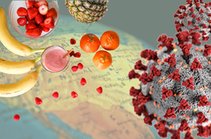
There is little practical clinical guidance for nutritional care during recovery of COVID-19, even though it can impact recovery time and people’s ability to return to doing the things that matter most to them. Nutrition is vital for maintaining skeletal muscle and avoiding metabolic disturbances and when patients are spending around two weeks in ICU, these can become very serious issues. Respiratory difficulties add an extra layer of complexity, preventing patients from eating effectively. A huge proportion of the patients we have treated required assisted ventilation, making it difficult to provide food and oral supplements. Nutrition is vital for maintaining skeletal muscle and avoiding metabolic disturbances - when patients are spending around two weeks in ICU, these can become very serious issues. This has meant that nutrition has had to become an important part of COVID-19 patient’s recovery.
- Viral Pneumonia-Respiratory Failure
- Obesity and Diabetes
Related Keywords: Food | Food Industry | Food & Beverage | Food & Drink | ADME Process
Related Associations: Association of Food Scientists | International Association of Food Protection | The food industry association | The Association of Food Industries
Session on Nanotechnology in Food Science:

Food is considered a Nano food when nanoparticles are used during Cultivation, Production, Processing, or Packaging of the food. It does not mean atomically modified food or produced by Nano machines. Nanotechnology is having an impact on several aspects of food science from how food is grown to how it is packaged. Companies are developing nanomaterials that will make a difference not only in the taste of food, but also in food safety, and the health benefits that food delivers. Nanoparticles are being developed that will deliver vitamins or other nutrients in food and beverages without affecting the taste or appearance. Nanotechnology will extend food shelf life by invisible, edible, Nano wrappers which will envelope foods preventing gas and moisture exchange.
- Better Packaging
- Improved Storage
- Contamination Sensor
- Improving texture and flavour
- Nutritional Value and Safety
- Usage of Additives
Related Keywords: Food | Food Industry | Food & Beverage | Food & Drink | ADME Process
Related Associations: Association of Food Scientists | International Association of Food Protection | The food industry association | The Association of Food Industries
Session on Medicinal Foods and Nutraceuticals:

Food for medical function is used to accomplish the diet regime of patients with specific diseases, disorders or medical condition. It comprises dietary products with cause of nutrition for food activities, drug and medicine.
Medical foods will defers form person to person based on the disease and the medication they are using.
Nutraceuticals are the medical foods which give health benefits of basic nutrition that averts and cure diseases. The products are natural supplement and organic which does not exist as a steady category.
- Potential and Established Nutraceuticals
- Probiotics & Prebiotics
- Prevention of Chronic Diseases
- Inorganic Mineral Supplements
- Basic Nutrition
Related Keywords: Food | Food Industry | Food & Beverage | Food & Drink | ADME Process
Related Associations: Association of Food Scientists | International Association of Food Protection | The food industry association | The Association of Food Industries
Session on Pregnancy and Pre-Pregnancy Nutrition:

Many women don't eat a well-balanced diet earlier pregnancy and may not have the appropriate nutritional status for the loads of pregnancy. Generally, a pregnant woman desires to add about 300 extra calories daily after the first trimester to meet the needs of her body and her developing baby. Pregnancy is the foremost phase in a women’s life. When they want nutrition for the baby to grow healthy. The assistance from nutritionist will boost the awareness in patients on how to take care the baby.
It is significant to eat nutritious food before you become pregnant because good nutrition supports your baby during the first trimester (three months) as their lungs, heart, brain and other important organs start to develop. Now days there are several malnutrition cases increasing everywhere the world because of the absence of nutrients in the food reserved by the pregnancy women’s.
- Diet during Pregnancy
- Physiology of Lactation
- Supplements for Pregnancy Women
- Risk of Pregnancy
- Physiological Changes in Pregnancy
Related Keywords: Food | Food Industry | Food & Beverage | Food & Drink | ADME Process
Related Associations: Association of Food Scientists | International Association of Food Protection | The food industry association | The Association of Food Industries
Session on Lactating Nutrition and Breast Feeding:

Breastfeeding uses a lot of energy and nutrients. It is important that your diet supplies the nutrients you need during breastfeeding, such as protein, Iron, calcium and vitamins. Need these nutrients for your own health and welfare. It provides 100% Daily Value of vitamins, and extra amounts of vitamins known to be especially important for lactating women. Breast milk also contains antibodies, growth factors, essential fatty acids, and hormones that protect your baby from illness.
- Complementary Feeding
- Infant and Child Nutrition
- Malnutrition in Children
- Essential Vitamins and Minerals
- Infant Formula and Growing up Milk
Related Keywords: Food | Food Industry | Food & Beverage | Food & Drink | ADME Process
Related Associations: Association of Food Scientists | International Association of Food Protection | The food industry association | The Association of Food Industries
Session on Livestock and Plant based Nutrition:

Animal nutrition focuses on the dietary needs of animals, primarily those in agriculture and food production, but also in zoos, aquariums, and wildlife management. There are seven major classes of nutrients: carbohydrates, fats, fibre, minerals, proteins, vitamins, and water. Nutritional Requirements of Livestock. The essential nutrients required by grazing animals are water, energy, protein, minerals, and vitamins. These nutrients are needed to maintain body weight, growth, reproduction, lactation, and health.
As plants need some essential nutrients to grow, hence plants usually take nutrition in the form of inorganic materials. A plant usually gets energy from photosynthesis and nutrition from soil. From soil nutrients can be given by the interaction of various steps and finally it provides nutrients to plants to grow. Plants also need micro and macro nutrients to propagate without any infections.
- Plant Nutrient Sources
- Animal Nutrient Sources
- Nutrient Deficiency in Plants and Animals
- Autotrophic and Heterotrophic Nutrition
Related Keywords: Food | Food Industry | Food & Beverage | Food & Drink | ADME Process
Related Associations: Association of Food Scientists | International Association of Food Protection | The food industry association | The Association of Food Industries
Session on Food Innovation and Eating Disorder:


Innovation is the lifeblood of the food industry and is essential for ensuring profitability and survival. Consumer demands and expectations are constantly evolving and retailers are seeking new products to meet these needs. Companies who have a clear understanding of the consumer and market place will emerge as strong and sustainable businesses. To achieve, food companies must have in place a formal, market focused innovation system to actively manage all stages of the process.
An eating disorder is a condition in which a person takes excessive food intake which affects a person’s physical or mental health Eating disorders includes intense emotions and abnormal behaviours around food and weight. It is important to know that eating disorders are mental illnesses, and they are not simply a lifestyle choice.
- Binge Eating Disorder
- Nutritional Disorder
- Iodine Disorder
- Food Beverage Innovation
- Vertical Farming
- Super Crops
Related Keywords: Food | Food Industry | Food & Beverage | Food & Drink | ADME Process
Related Associations: Association of Food Scientists | International Association of Food Protection | The food industry association | The Association of Food Industries
Session on Nutrition and Diabetes:

A vigorous diet is vital for overall health and well-being, for maintenance of normal growth, development and ageing and for maintenance of a healthy body weight. It also diminishes the risk of diseases leading to overall build-up of healthy individual.
An excessive diet can source k which in turn leads to diseases such as blindness, scurvy, preterm birth, stillbirth and anaemia. A morbid diet can also cause nutrient excess foremost to conditions such as obesity, cardiovascular disease, diabetes and osteoporosis.
Glucose present in the blood attained from consumed food is the key source of energy. Insulin released by pancreas benefits in absorption of glucose from into the cells to produce energy required to carry out cell processes and functions. Insufficient production or no production of insulin by pancreas can lead to an abnormal increase in blood glucose levels, a condition known as diabetes.
- Type I Diabetes
- Type II Diabetes
- Gestational Diabetes
- Monogenic Diabetes
Related Keywords: Food | Food Industry | Food & Beverage | Food & Drink | ADME Process
Related Associations: Association of Food Scientists | International Association of Food Protection | The food industry association | The Association of Food Industries
Session on Nutritional Deficiencies:

Nutritional deficiencies primarily occur when a person doesn't take adequate essential nutrients. An insufficient consumption of essential nutrients like proteins, vitamins, carbohydrates etc., in the intake can lead to Nutritional deficiency. It can be overwhelmed by consumption of balanced diet or taking supplements to balance the scarce nutrients in the body. A healthy, nutritious and balanced diet is crucial for the overall health and well-being.
- Iron deficiency
- Iodine deficiency
- Vitamin D deficiency
- Vitamin B12 deficiency
- Calcium deficiency
- Vitamin A deficiency
- Magnesium deficiency
Related Keywords: Food | Food Industry | Food & Beverage | Food & Drink | ADME Process
Related Associations: Association of Food Scientists | International Association of Food Protection | The food industry association | The Association of Food Industries
Session on Food Packaging Technology:

Food packaging is packaging for food. A package provides protection, tampering resistance, and special physical, chemical, or biological needs. It may bear a nutrition facts label and other information about food being offered for sale. After use, organic matter that is still in the food packaging needs to be separated from the packaging. This may also require rinsing of the food packaging. It is critical to maintain food safety during processing, packaging, storage, logistics (including cold chain), sale, and use. Conformance to applicable regulations is mandatory. All aspects of food production, including packaging, are tightly controlled and have regulatory requirements. Uniformity, cleanliness and other requirements are needed to maintain Good Manufacturing Practices.
- Barrier to Moisture (Oxygen, UV light)
- Physical Damage Resistance
- Printability Features
- Types of Packaging
Related Keywords: Food | Food Industry | Food & Beverage | Food & Drink | ADME Process
Related Associations: Association of Food Scientists | International Association of Food Protection | The food industry association | The Association of Food Industries
Session on Dental Nutrition:

Nutrition plays a key role in oral and dental health. Similarly, oral health affects nutrition status and diet intake. Consumption of much cariogenic nutrients such as sugar affects dental and gum health. The awareness of dietary practices that affect the oral health is an essential component in the dental care system.
Eating a healthy diet is extraordinarily necessary to guard you from one common problem: cavity. If you eat innumerable sugary foods or drink sugary beverages, your teeth will cause cavity. In different words, all that sugar will eat holes into your teeth. Even fruit juices or milk that is typically healthy, also contain sugars. For very healthy teeth, don’t drink sodas or different terribly sugary drinks in any respect.
You wish to guard your teeth, gums and mouth; you'll begin by removing or limiting sure foods from your diet. Sugar is one amongst the worst foods for your teeth’s health. If fully removing sugar from your diet is just too troublesome, value more highly to eat sweets aboard different foods, which might facilitate “wash away” any sugar remaining on the teeth and gums. Acidic foods, appreciate pickles, breath mints or citrus juices, may also harm your teeth. Like several different harmful foods, they're best once consumed aboard different foods, and you'll facilitate avoid issues by brushing your teeth right.
- Balanced Diet
- Nutritional Assessment
- Oral Manifestations
- Vitamin Deficiencies
- Oral Diseases
Related Keywords: Food | Food Industry | Food & Beverage | Food & Drink | ADME Process
Related Associations: Association of Food Scientists | International Association of Food Protection | The food industry association | The Association of Food Industries
Market Analysis
Market of food and Nutrition supplements market has seen a phenomenal spike in manufacture and sales. This has empowered various new Industries to dive into the business sector with goods that guarantee to be the remedy for youth, wellbeing, and essentialness. As directed by the Nutritional journals, the nutritional supplement market worldwide is estimated to be $104 billion.
Sports nutrition consumers in Italy are becoming increasingly educated about the different types of products available and their aims. While, initially, consumers’ main concerns were to build up muscle and hence they opted for sports protein, they are now becoming increasingly aware of the efficacy of products positioned for energy increase, endurance, recovery and strength. In Italy foodservice market is likely to witness a CAGR of 1.24% during the forecast period (2019 - 2024).
The Global agricultural industry market is estimated to be about $8.7 trillion according to the Plunkett Research estimate. Global Food Export alone is estimated at around $1.47 trillion in 2017 according to the world trade organization. The cost of food varies in every region which makes it a bit difficult to learn about. It varies due to various factors which include location, Food manufacturing industries, food transportation, food storage and climate. As per the demand, Fast food industry is also growing at an alarming rate. The fast food industry includes processing, development, branding and advertising.
The fast food industry is expected to grow at a CAGR of 5.5% from 2016 to 2024. It mostly is due to the changes in eating habits of most of the people. Globally, Fast food generates around $550 billion dollars and it is assumed that around 2 million people work in the fast food industry. Due to poor diet habits and poor diet choices, most people suffer from nutritional deficiencies and disorders.
While Canada, Singapore and other European countries spend relatively less portion of their income on food equatorial countries like India, Pakistan and Africa spend relatively more portion of their income on food. The retail grocery industry in the US alone makes around $650 billion in revenue in 2018 according to the U.S. Department of the census.
According to Markets, the global nutritional analysis market size is estimated to be valued at USD 5.4 billion in 2021 and projected to reach USD 7.9 billion by 2026, recording a CAGR of 8.3% during the forecast period. The market is strongly driven by shifting consumer preferences, rising health awareness, growing millennial population, and increase in supplementary income among consumers. The convergence of major industry trends is giving rise to new opportunities for key players in the industry. Changing lifestyles and high prevalence of chronic diseases are the key factors driving the demand for nutritional analysis. The growing positive outlook towards sports nutrition would also positively impact the nutritional analysis market.
Food nutritional analysis testing has been witnessing improvements in technology, with the time taken now being one to three weeks for nutritional analysis through advanced and rapid testing. Sample preparation, which involves the extraction of analyses and separation of potential analyses, takes approximately 60% of the total time of the sample being analysed. The preparation of the report is estimated to account for 20%–25% of the total time. The results obtained after comprehensive testing are used to direct the food manufacturing cycle. Nutritional analysis services are mostly used for new product development and nutritional labelling purposes. The delays in reports being generated result in delays in further processing of product development or product launch in the market.


